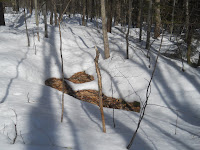Patterns in Nature, Beethoven, and the Art of Fuguing
The harmonic overtone series
is wholly natural, is it not? Air columns and strings (and planets,
according to Pythagoras and Kepler) vibrate. The fundamental tones we
hear most obviously include other tones—if your hearing is acute
enough—comprising the entire diatonic scale we've been using to
compose music since the 1500s and before. It could be argued that all
the scales used in the world's systems of music come in some way from
the natural system of harmonics arising from vibrating objects.
The patterns that fill
pages and pages of western art music rest on this harmonic
foundation. More music in that language continue to fall out of the
sky and into my pencil whenever I show up to compose. A recent
project is creating a fugue from a very simple progression of fifths.
I did not begin this fugue consciously. I thought I was simply
writing down some improvised counterpoint using the progression. But
it turned out that the patterns of a fugue began to emerge on the
page. I say “on the page” consciously because it isn't until I
write music down that it begins its traverse from the accidental to
the intentional.
At this point in the
project, what I have is a slightly tangled braid of three voices and
three “themes” all of which fell out of that set of five
descending fifths followed by an ascending major second during many
improvising sessions. The six notes of the opening create a pleasing
chord to my ear on my resonant piano in my reverberating living room.
Arranged in a different way, the notes create something like a scale
figure that comprises the second theme, and could be said to have
created the third theme. I am consciously working at creating the
fugue now. I work very slowly checking the sounds by playing them,
using colored pencils to delineate the separate voices, writing in
three staves so that I don't get too confused in my articulation of
the ways these three themes can interweave and become one whole. My
own will takes a kind of back seat in this work. I want to imagine it
is akin to what Hegel meant by Scientific Cognition in his preface to
The Phenomenology of Spirit. He says in paragraph 13 “Without such
articulation {the former range of specificity of content} Science
lacks universal intelligibility and gives the appearance of being the
esoteric possession of a few individuals.” (Miller p. 7)
 |
| image by skeeze on pixabay |
All this cogitation made me
remember my recent fascination with a mathematical reality (or is it imaginary) that has
some correlates in nature. Some of you might think, given my history
of obsession with it that I'm about to talk about Fibonacci. However,
this time I'm talking about The Mandlebrot Set. Benoit Mandelbrot coined the
word fractal. Jimi Sol made an explanatory video about Mandelbrot
sets—so named in tribute to Benoit Mandelbrot—that explains what
is exciting about the ideas behind the beauty of fractals much better
than I could. My trip down the rabbit hole also reveals Julia Julia sets and Fatou sets--also named for mathemeticians--and also responsible for creating beautiful fractal art and beautiful natural surroundings like coastlines and cumulous clouds. And believe it or not this trip down the rabbit hole acted a bit like a fractal in that it lead me back to my favorite mathematical toy: Fibonacci.
One idea that comes from all
this work in imaginary and real numbers is that of self-organizing
principles. That concept is everywhere these days from economics to
ecosystems. This link will take you to a rich Wikipedia article
about the ways we are coming to know that “design” does not mean
a central intelligence is necessarily at work, no matter what Thomas
Aquinas claimed.
Let me get back to the piano, though. I think these kinds of thoughts often when I'm deeply immersed in a note-learning project. I have had the luxury of that immersion these last few weeks in the company of Beethoven. Part of the upcoming Music as Meditation is a performance of Beethoven's violin sonata opus 30 number 1. It is a beautiful link in the transition between classical and romantic music. It's phrases are full of patterns with which one must grapple in learning the notes. As the little patterns become clearer, so does the pattern that governs the cohesiveness of the whole. My intuition tells me that there is something like an aesthetic sense of the order of reality that causes Beethoven (and maybe even to a small degree causes me) to choose just the right notes to fill each iteration of a phrase as it repeats within the structure of a larger piece. Sometimes my rational understanding can corroborate what my intuition tells me, but not always. Still, I always experience Beethoven's notes as just the right notes at just the right time.
There's more to mention, but I really need to practice! I could go on about how Bohuslav Martinů uses the form of madrigals to create a well-ordered whole from many voices. I could talk about the cross sections of walnuts and the form of whipens. I will leave this ramble here, though, and hope that many of you can come to Music as Meditation. It's at Christ Church in North Conway, New Hampshire on Sunday, January 5 at 5 PM. Admission is free. Together some of us are pitching in to take care of the Steinway piano at that church so we can keep gathering to share music. Please get in touch with me if you want to contribute to that care.






















